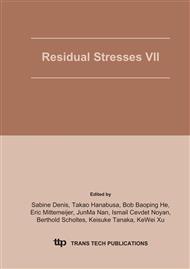p.358
p.364
p.370
p.376
p.384
p.390
p.396
p.404
p.409
Approach of Residual Stress Generated by Deep Rolling Application to the Reinforcement of the Fatigue Resistance of Crankshafts
Abstract:
In the new types of diesel motors, the crankshaft loads increase dramatically. For that reason, to satisfy the requirements and needs of its motorist’s customers, ASCOMETAL has developed a special bending fatigue test applied to “Baldwin” specimens reinforced by deep rolling. Such test is representative of the main in-service loads existing in crankshaft crankpin fillets (one of the weakest point of the component). Thus, using this test, the mechanisms leading to the increase of the fatigue resistance brought by the deep rolling treatment, could be identified. This reinforcement is mainly linked to crack arrest due to both a decrease of the in-depth stress concentration factor and to remaining compressive residual stresses induced by the deep rolling. In this paper, the experimental methods (in particular X-rays diffraction) used to characterize the stress fields generated by the deep rolling treatment are described first. The equations of equilibrium and compatibility of the particular toric symmetry of the crankshaft crankpin fillets have been used then to analyze the surface and in-depth stress profiles of the tested sample. This allowed characterizing the shake down and stress relaxation induced by fatigue. The crack propagation behaviour and the associated fracture limits were also defined.
Info:
Periodical:
Pages:
384-389
Citation:
Online since:
July 2005
Authors:
Keywords:
Price:
Сopyright:
© 2005 Trans Tech Publications Ltd. All Rights Reserved
Share:
Citation:


